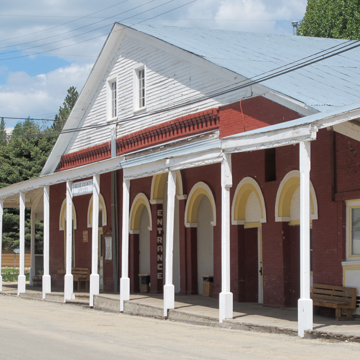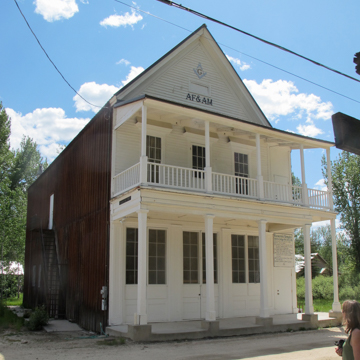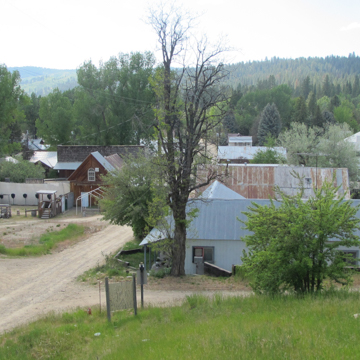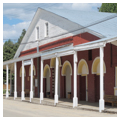You are here
Idaho City
Idaho City is a small mountain village thirty-six miles northeast of Boise. Rumors of large gold fields reported by George Grimes and Moses Splawn in 1862 caused gold seekers—many from Walla Walla, Washington, and from the Confederate South—to pour into the Boise Basin. Of several area gold camps, what was originally known as Bannock or West Bannock provided the best access to water and thus it became the major camp—and eventually Idaho’s most productive Gold Rush town. Its name eventually changed to Idaho City, to distinguish it from the large mining town of Bannack in southwestern Montana.
Like other boomtowns in the West, Idaho City grew almost overnight. At its peak, in the mid-1860s, Idaho City had a population of 7,000—the Northwest’s largest city, bigger even than Portland. During the most active mining efforts, more than half of the population consisted of Chinese immigrants working as miners and support workers. Idaho City’s location within what is now the Boise National Forest meant the building material of choice during the Gold Rush days was wood—a fire hazard. Indeed, Idaho City experienced two major fires, in 1865 and 1867. Later construction efforts employed brick. After more than a century, fifteen extant buildings serve as reminders of Idaho’s early pioneer days.
Many of the early structures were community spaces, such as churches and lodges, and were simple boxes with a gable roof and limited semblances of Gothic or classical details. Established in 1863, the present St. Joseph’s Catholic Church, rebuilt in thirty days following the 1867 fire, is a simple, Gothic Revival structure sitting high on a hill overlooking town. For many years, St. Joseph’s was the only church in Idaho City. On an adjacent hill, also overlooking town, the I.O.O.F. Hall, designed by D. Fergason and built in 1865 by A. B. Morrill for $1,974, is the oldest Odd Fellows lodge in Idaho.
In 1863, Joseph and Thomas Butler founded the Boise News. The newspaper occupied several other locations before 1886, when then publisher C.E. Jones purchased a building on the corner of Commercial and Main streets. The former tin shop and warehouse had been built in 1867, during Idaho City’s heyday. Built of local, low-fired brick, the rectangular, single-story structure features, like many of the Main Street storefronts, wide covered porches supported by plain columns on the west (front) and south sides. The building was previously occupied by a store known as Man Wo Corner. The newspaper was later renamed the Idaho World, and remains Idaho’s oldest continuing newspaper.
In addition to Man Wo Corner, another Chinese-owned business was the Pon Yam House on the corner of Montgomery and Commercial streets. The structure served as both a store and the residence of the prosperous merchant Pon Yam. The single-story brick building has a gabled roof and covered porches on the south and west elevations, and features arched door and window openings. A small, wooden addition to the east contains an elaborate, Italianate bay window. The store catered to local Chinese laborers, selling foods such as cuttlefish, bean curd, dried oysters, and bamboo shoots, and others wares like Chinese books, clothing, firecrackers, and religious articles. The Pon Yam House now operates as a museum and has been recently renovated.
On the corner of Main and Wall streets, the single-story brick building that has served as the Boise County Courthouse since 1909 was originally built in 1871 as a general store. Its iron folding doors, each weighing half a ton, were made in San Francisco and shipped up the Columbia River before being carted by ox and horse teams to Idaho City. The interior has since been restored with furnishings to reflect the original 1863 court building that was located on Commercial Street.
The oldest Masonic Hall west of the Mississippi River that still in use is Idaho City’s Masonic Temple on Wall Street, built in 1865. Following modest alterations between 1928 and 1953, the two-story frame building is now painted white and features simple classical details. The 1867 post office, a single-story brick edifice with a brick parapet that partially conceals a wooden gable roof, is now occupied by the Boise Basin Museum, which features artifacts of the mining era such as photos, gold scales, guns, and a blackjack table. The latter is indicative of the entertainment pursuits available in the town, which included gambling, billiards, theaters (there were two in 1864), and drinking.
Idaho City’s population fell to below 900 by 1870 and was down to 104 by 1920. The easily worked basin stream gravels yielded most of their gold, and soon after 1870, miners, for the next fifty years, shifted their attention to large hydraulic dredges. With the exception of wartime lulls, gold mining continued in and around Idaho City until the early 1950s. By the time mining was generally exhausted, more than 3,000,000 ounces of gold had come from the basin. The town’s population continued to decline over the years. In 1974, the Historic American Buildings Survey documented the extant 1860s structures, and the town was designated a historic district the following year. Since the turn of the twenty-first century, the town’s population has stabilized at around 500. Idaho City remains the Boise County seat and is a popular site for daytrips from the Boise metropolitan area. The town’s current economy relies on hunting and fishing tourism and visitors utilizing the town’s natural hot spring pools.
References
Attebery, Jennifer Eastman. Building Idaho: An Architectural History. Moscow: University of Idaho Press, 1991.
Minskoff, Alan, “Idaho World Building,” Boise County, Idaho. Historic American Buildings Survey, 1974. Prints and Photographs Division, Library of Congress (HABS ID 8-IDC1, 5-).
Neil, J. Meredith. Saints and Oddfellows: A Bicentennial Sampler of Idaho Architecture. Boise, ID: Boise Gallery of Art Association, 1976.
Renk, Nancy, “Idaho City,” Boise County, Idaho. National Register of Historic Places Inventory–Nomination Form, 1972. National Park Service, U.S. Department of the Interior, Washington, D.C.
Writing Credits
If SAH Archipedia has been useful to you, please consider supporting it.
SAH Archipedia tells the story of the United States through its buildings, landscapes, and cities. This freely available resource empowers the public with authoritative knowledge that deepens their understanding and appreciation of the built environment. But the Society of Architectural Historians, which created SAH Archipedia with University of Virginia Press, needs your support to maintain the high-caliber research, writing, photography, cartography, editing, design, and programming that make SAH Archipedia a trusted online resource available to all who value the history of place, heritage tourism, and learning.


















